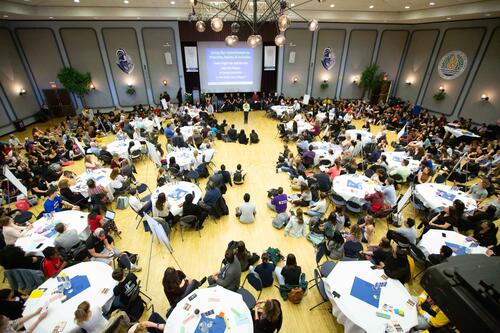
Cultivating Community event (SUNY Geneseo/Keith Walters '11)
Author
Additional Authors and Editors
Publication
Summary
With dialogue, students and faculty can work together to address diversity, equity, inclusion, accessibility, and belonging (DEIAB) within higher education settings.
Abstract
A challenge for fostering diversity, equity, inclusion, accessibility, and belonging (DEIAB) in institutions of education is bridging the gap between students and faculty. However, community efforts in DEIAB can benefit from dialogue between faculty and students for long-term efficacy. Drawing from a dialogue-based approach to organizational communication, this practice brief aims to promote student–faculty collaborative action to improve campus diversity, equity, inclusion, accessibility, and belonging efforts. To this end, this article presents (a) dialogic departmental committees comprised of students and faculty members in two academic disciplines, (b) the endeavors informed by research on community change, and (c) lessons learned from our initiatives for future efforts.
Main research questions
1. How have student-faculty DEIAB committees formed across different disciplines?
2. What challenges are faced by DEIAB committees in reaching their common goals?
3. What are the impacts of collaborative DEIAB committees on participating students and faculty?
What the research builds on
In advocating for the oppressed, the problem of speaking on behalf of others, including in higher education, has been discussed for decades. We join these authors in advocating for the act of speaking with others, working from a foundation of dialogue. In this study, we describe how dialogic encounters among faculty and students can be used to challenge systemic separation of them around DEIAB initiatives on campus. To contextualize this work, we follow the framework of communications scholars LeGreco et al. (2024), who highlight four characteristics of dialogue—mindfulness, equitable transaction, empathy, and real meeting, each of which provide important opportunities for connection and to foster collaboration. The Bio-Diversity and CommunicationIDEA committees use these practices to work together toward common DEIAB goals, addressing how to implement these ideas and lessons learned under this structure.
Additional information
Shared lessons for DEIAB Departmental work:
- Remember that DEIAB efforts are not isolated to one space or to one issue. Connect with other programs and leverage the power of cross-identity collaboration.
- Consider how roles and identities intersect and the implications of those intersections.
- Prioritize equity over equality.
- Focus on building trust to lay the foundation for equitable transaction, mindful communication, and empathy.
- During committee and departmental discussions of DEIB-related issues, address any comments that are hurtful or inconsiderate directly—for example through unpacking meaning, recognizing impact, and apologizing—respecting colleagues, but being open about our own fallibility. Vulnerability in these discussions requires that faculty step away from traditional student-faculty hierarchies and be willing to cede power for the sake of growth and community.
- Develop processes of welcoming and including new members. Students and faculty can encourage sustained participation to support trust building. Share the emotional load of DEIAB work with allies among faculty and students and connect with like-minded individuals who are willing to work to be a part of the solution.
- Express gratitude. Celebrate and share success along the way.
Some questions to reflect on when starting new DEIAB partnerships between students and faculty:
- To what degree are you prepared to practice vulnerability, including your identity-related experiences and/or expressing humility?
- DEIAB work takes us to different spaces with new people. Are you prepared to meet people where they are?
- To what degree are you prepared to reflect, to listen to other perspectives, and to possibly receive and learn from criticism?
- Are you prepared to commit the resource of time?
- Who would be open to engaging in authentic dialogue and challenging oppressive narratives with you?
- What are your intended goals for DEIAB in your specific community?
- How can you gather support for your work?
Citation:
Kanemoto, E., Craig, M. J., Gerringer, M. E., Lewis, J., Lynch, A., Michaels, A., Smith, H. M., Yang, S., Yeoh, J., & Harrigan, M. M. (2024). Reimagining student–faculty relationships: Strengthening social justice efforts through dialogue. Journal of Diversity in Higher Education.